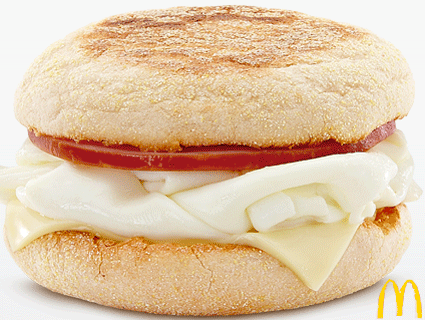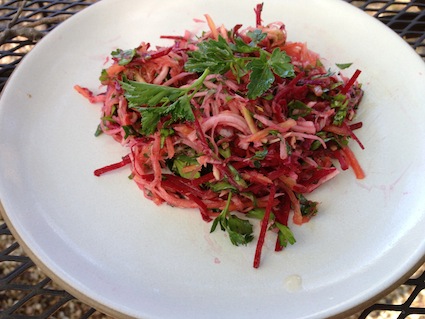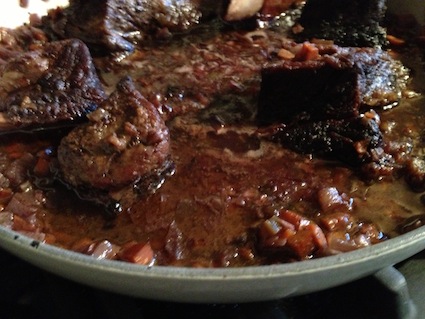
The McDonald's Egg White Delight McMuffin<p>Image courtesy of <a href="http://www.mcdonalds.com/us/en/food/product_nutrition.breakfast.1079.egg-white-delight.html" target="_blank">McDonald's</a>.</p>
According to the Centers for Disease Control and Prevention, 69 percent of US adults are overweight or obese. How did this happen? In a long article in the current Atlantic, David H. Freedman offers a mechanistic explanation: People are ingesting too many calories, particularly “energy-intense” fat, sugar, and “other problem carbs.” The simple diagnoses leads to an easy solution: The food industry should apply its flavor-engineering wizardry to churn out lower-cal products that people will still scarf up, preserving its own bottom line while solving the obesity crisis. Indeed, he writes, this remedy is already playing out under our noses:
Popular food producers, fast-food chains among them, are already applying various tricks and technologies to create less caloric and more satiating versions of their junky fare that nonetheless retain much of the appeal of the originals, and could be induced to go much further.
Among the examples Freedman cites are McDonald’s Egg White Delight McMuffin, a “lower-calorie, less fatty version of the Egg McMuffin,” a “new line of quarter-pound burgers, to be served on buns containing whole grains,” and Carl’s Jr.’s “Charbroiled Atlantic Cod Fish Sandwich.”
And what of food industry critics like Michael Pollan and Mark Bittman, who who urge people to eat “real food” and reject highly processed fare, even in low-cal versions? They—we I guess I should say we—are part of the problem.
How? First of all, the “real food” we push includes—gasp—fat. “Many of the dishes glorified by the wholesome-food movement,” Freedman frets, “are as caloric and obesogenic as anything served in a Burger King.” He reports watching aghast as Bittman, appearing on the Today Show, whipped up a “lovely dish of corn sautéed in bacon fat and topped with bacon.” He adds: “Anyone who thinks that such a thing is much healthier than a Whopper just hasn’t been paying attention to obesity science for the past few decades.”
Then there’s the Pollanites’ relentless criticism of Big Food, even when it’s ramping down calories. “By placing wholesome eating directly at odds with healthier processed foods, the Pollanites threaten to derail the reformation of fast food just as it’s starting to gain traction,” Freedman warns. We are, in short, holding up progress, and we need to shut up and accept, as the article’s title has it, that “junk food can end obesity.”
Except, not so fast. First of all, I object to Freedman’s out-of-hand demonization of fat. “Fat carries more than twice as many calories as carbohydrates and proteins do per gram,” Freedman writes, “which means just a little fat can turn a serving of food into a calorie bomb.”
And so he avoids it. He reveals in the article that he has taken to dressing his salads with straight vinegar, since he’s “long hated the taste of low-fat dressing.” And he admits to having been a “big fan” of an early ’90s McDonalds’ product called the McLean Deluxe, a “healthier version of the Quarter Pounder, made with extra-lean beef infused with seaweed extract.” And several times in the piece he pauses to gape in horror at the amount of fat found in “real food” dishes—I’m sure he’d howl in outrage at the recipes in my Tom’s Kitchen series, with their easy hand with olive oil.
In fact, after reading the piece, I realized that Freedman is really pining for an old, mostly discarded food trend: the “low-fat” craze that flourished starting 30 or so years ago. For me, (dietary) fat phobia peaked at some point in the 1990s, when I discovered lurking in my mother’s refrigerator a carton of pre-made “fat-free guacamole.” What? Some food-industry genius had managed to strip out the very thing that makes guacamole not only delicious but nutritious—the glorious fat in avocados.
Forget for a second that the low-fat-everything moment occurred right during the time frame—the 1980s and ’90s—when US obesity rates were surging. The problem here is that there’s no real evidence that consuming fat, per se, causes obesity or related health problems. The French, for example, are famous for their love of butter, cream, eggs, and animal fat—but their obesity rates only started creeping up when they began to shun their traditional diet and embrace processed food. Same with Italians and their olive oil.
But there is real evidence that, by foregoing oil in his salad dressing, Freedman is also foregoing vital nutrients. A recent study by Purdue researchers found that people eating fat-free and low-fat salad dressings didn’t fully absorb fat-soluble carotenoids in salads—depriving them of compounds “associated with reduced risk of several chronic and degenerative diseases such as cancer, cardiovascular disease and macular degeneration.”
Meanwhile, research has consistently indicated—latest here—that a Mediterranean-style diet, rich in fat from olive, nuts, and moderate amounts of meat and fish—plus plenty of vegetables and fruit—leads to low levels of cardiovascular disease and other forms of diet-related health mayhem. Even the pork fat Bittman used to enliven his corn dish is probably just fine in moderate quantities.
My more fundamental objection to Freedman’s piece is that his basic framework—we’re fatter because we’re consuming more calories, and thus calorie reduction will reverse the problem—is probably too simplistic. In a brilliant essay in Aeon, David Berreby dismantles the calories-in, calories-out model of weight utilized by the likes of Freedman.
He notes that it isn’t just US humans that have packed on pounds over the past three decades. It’s also marmosets, as well as “laboratory macaques, chimpanzees, vervet monkeys and mice, as well as domestic dogs, domestic cats, and domestic and feral rats from both rural and urban areas.” It’s easy to imagine pets getting fattened up by indulgent owners, and rats growing obese on our high-calorie trash, Berreby notes. But lab animals present a more challenging case to explain:
In fact, lab animals’ lives are so precisely watched and measured that the researchers can rule out accidental human influence: records show those creatures gained weight over decades without any significant change in their diet or activities.
So what’s making us fatter if calories alone can’t fully explain it? Berreby offers no definitive answer, because no one has definitively figured it out. He does offer some of possible contributors, from industrial chemicals like BPA that leach into our food and may stimulate the production of fat molecules to short-term hereditary factors—it turns out that “where mothers have gone hungry, their offspring are at a greater risk of obesity.”
All of which suggests that the food industry’s quest to replace some fat and sugar with low-cal substances that taste like fat and sugar might be futile.
So what’s my answer to the obesity problem? I agree with Freedman that the movement to convince people to reject convenience fare in favor of “real” (i.e., minimally processed) whole foods faces steep challenges—not least of which is Big Food’s gargantuan marketing budget. I don’t object to a kinder, gentler form of corporate fast food—I would applaud the the industry if it made a serious push to ditch its old “supersize” profit model and promote less caloric foods. But the fact remains that highly processed diets have a history of ruining people’s health, and “real food” diets have the opposite track record. They may yet prove to be the best strategy we have for addressing our mounting diet-related health troubles. And hey, real food can be pretty convenient, too—check out Bittman’s old Minimalist column. And fast food itself has a history that long predates its takeover by corporations.
















